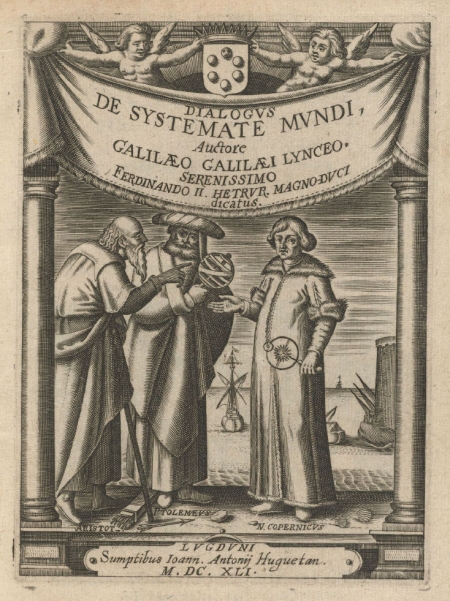
In 1543, the appearance of two books marked the start of the scientific revolution: Vesalius’s De humani corporis fabrica and Copernicus’s De Revolutionibus.
In the former, Vesalius’s many groundbreaking anatomical findings are displayed with extraordinarily detailed woodcut engravings. In the latter, simpler diagrams help to communicate the revolutionary theory of heliocentrism. Houghton Library holds first editions of both works.

De Revolutionibus marked the beginning of a remarkable century for astronomy. Tycho Brahe, Johannes Kepler, and Galileo Galilei published landmark works on optics, the laws of planetary motion, and the nature of stars and comets. Houghton’s collection includes first editions of the works of all three astronomers. Among them is 1632 copy of Galileo’s Dialogo dei massimi sistemi — a book suppressed by the Inquisition the following year — and Kepler’s Somnium, a description of a trip to the moon that is often called the first work of science fiction.
While astronomers looked to the stars, microscopists used novel optical technologies to investigate other unknown territories.
The pioneering work of Antonie van Leeuwenhoek, the first observer of single-celled organisms, is recorded in numerous 17th-century volumes in the collection. Robert Hooke’s hugely influential Micrographia (1665), of which Houghton holds two first-edition copies, features beautifully illustrated examinations of insect and plant tissues.
In the 17th century, scholars took up questions of scientific method in a more systemic way than ever before. René Descartes’ Discours de la Methode (1637) and Francis Bacon’s Novum Organum Scientiarum (1620) (books whose early editions feature in the Houghton collection) attempted to identify methods of reasoning and experimenting sure to solidly ground human knowledge. Robert Boyle, the founder of modern chemistry, may have consulted these works in designing the experiments described in his hugely influential The Sceptical Chymist (1661). Houghton’s collection of Boyle’s work is outstanding: virtually all of his published work is present in early editions, and the library's first-edition copy of the Sceptical Chymist once belonged to John Locke.
Works in the collection from the late 17th through the end of the 18th century reflect dramatic changes in the cultural reception of scientific thinking. The first scientific journals appeared, including the Journal des sçavans and Philosophical Transactions of the Royal Society, both founded in 1665. Original copies of these and other, contemporaneous journals are housed in Houghton, along with volumes designed to make the discoveries of scientific revolution accessible to the general public. An example of one such book is Francesco Algarotti’s best-selling 1737 work Il Newtonianismo per le dame (Newtonianism for women), which helped to popularize the central theories of Newton’s Philosophiae naturalis principia mathematica, of which Houghton holds two first-edition 1687 copies.
Accessing These Materials
Houghton's history of science collections are cataloged in HOLLIS. Please contact the library if we can offer any assistance in finding materials.